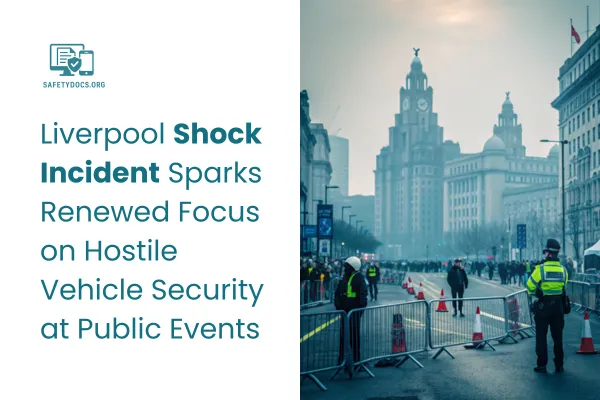
Liverpool Event Sparks Urgent HVM Discussions
26 May 2025 – What should have been a day of celebration in Liverpool took a frightening turn when a vehicle breached a busy pedestrian area, injuring several members of the public. While a formal investigation is underway, initial reports point to a lack of adequate crowd protection barriers in the high-footfall zone.
This disturbing incident is a stark reminder of the growing need for effective Hostile Vehicle Mitigation (HVM) at street events, particularly those in busy city centres, public squares, and open-access venues.
Understanding HVM: It’s More Than Just Bollards
Hostile Vehicle Mitigation involves a suite of strategies to deter, delay, or stop vehicles—whether driven deliberately or accidentally—from entering protected areas. This applies to both ramming attacks and vehicle-borne explosive threats.
Crucially, HVM isn’t just about placing barriers. It's about using the right barriers, in the right places, with expert guidance.
Planning a Safe Event? Here’s What You Must Know
According to guidance from the UK’s National Protective Security Authority (NPSA) and NaCTSO, integrating HVM into event planning is now essential, not optional.
1. Begin with a Vehicle Threat Assessment
Before thinking about barriers, you must understand the risks:
What types of vehicles could be used maliciously?
How fast could a vehicle get before reaching the crowd?
Is there a history of anti-social driving or extremist threats in the area?
A Vehicle Dynamics Assessment (VDA) carried out by certified professionals can help you determine the right type and rating of barriers for your event.
2. Choose the Right Kind of Temporary Barriers—Not Just Any Blocker
Bollards and temporary fences are not created equal. Only use impact-rated barriers tested to:
ISO 22343-1 (previously PAS 68 / IWA 14-1)
Vehicle Attack Delay Standard (VADS)
Barriers that meet both standards can withstand:
A heavy-duty vehicle moving at 48–80 km/h
Multiple low-speed ramming attempts
Without dual certification, your barriers might collapse on first impact—or even worse, give false reassurance.
3. Smart Barrier Placement: A Matter of Life and Death
Improperly placed barriers offer little protection. Event organisers must ensure:
No wide gaps: Air gaps should be less than 1.2 metres
Safe stand-off zones between the barrier and crowds
Uninterrupted pedestrian flow, including access for wheelchair users and pushchairs
Every metre matters. A misplaced barrier can expose the crowd to direct harm or compromise emergency escape routes.
4. Operational Control Is Critical
Barriers are not “set and forget.” Ask yourself:
Who has the keys or authority to move barriers if needed?
Have staff been briefed on emergency protocols?
Do barriers require manual monitoring?
An HVM solution is only as strong as the team behind it. Confusion or delays during an incident can cost lives.
5. Ensure Legal Compliance Before Installation
If you’re installing barriers that restrict public access or affect roads, you’ll likely need an Anti-Terrorism Traffic Regulation Order (ATTRO) under the Road Traffic Regulation Act 1984.
Skipping this step can expose you to legal liabilities or even force your event to shut down.
6. Work Closely with CTSA and Safety Advisory Groups
Your first call should be to your Counter Terrorism Security Advisor (CTSA) and local Safety Advisory Group (SAG). They’ll guide you on proportionate and lawful security planning.
Their involvement ensures your event is compliant, credible, and, more importantly, protected.
The Future of Event Safety: Martyn’s Law and Beyond
With the upcoming Martyn’s Law (Terrorism (Protection of Premises) Act 2025) coming into force, any event expecting over 800 attendees must include hostile vehicle mitigation as part of its safety plan. But even smaller gatherings are strongly advised to follow best practice.
The incident in Liverpool is a painful reminder of what’s at stake. But with expert planning, rated barriers, and proper collaboration, events can be both joyful and secure.
Useful Resources
ProtectUK: Martyn’s Law Factsheet
Counter Terrorism Security Advisors (CTSA)
Final Word
Festivals, parades, and community gatherings bring us together. But in an age of rising threats, public safety must come first. Don’t leave it to chance—invest in proper HVM planning, and ensure your event stays secure from start to finish.
Conclusion
The recent events in Liverpool serve as a sobering wake-up call for everyone involved in planning public gatherings. Hostile Vehicle Mitigation is not a luxury or an afterthought—it is a vital element of modern event safety. With the upcoming implementation of Martyn’s Law and the clear risks exposed by real-world incidents, there is no excuse for complacency.
Whether you're organising a street market, music festival, or community fair, proactive HVM planning can be the difference between a safe event and a tragic one. By engaging early with experts, selecting certified barriers, and working alongside CTSA and local authorities, you not only meet your legal obligations but also protect lives.